Type 3 Phymatous Rosacea Nose Disfigurement (Rhinophyma) + Other Facial Symptoms & Treatments
Transforming Your Look: Effective Solutions for Phymatous Rosacea Nose and Facial Disfigurement
Feeling like your Phymatous Rosacea nose is stealing all the attention, thanks to the Type 3 Rosacea symptoms you’re experiencing? You’re definitely not alone in this! Dive into some eye-opening research with us: out of 9190 folks looked at in various studies, just 7.4% have this particular kind of Rosacea.1 Yep, it’s pretty rare, and it’s high time we chat more about it, especially when it comes to getting the word out and understanding it better on a comprehensive level.
This challenging skin condition connects a whole community out there! It’s more than just a skin condition; it’s a feature of a wider national conversation on inflammatory skin diseases.
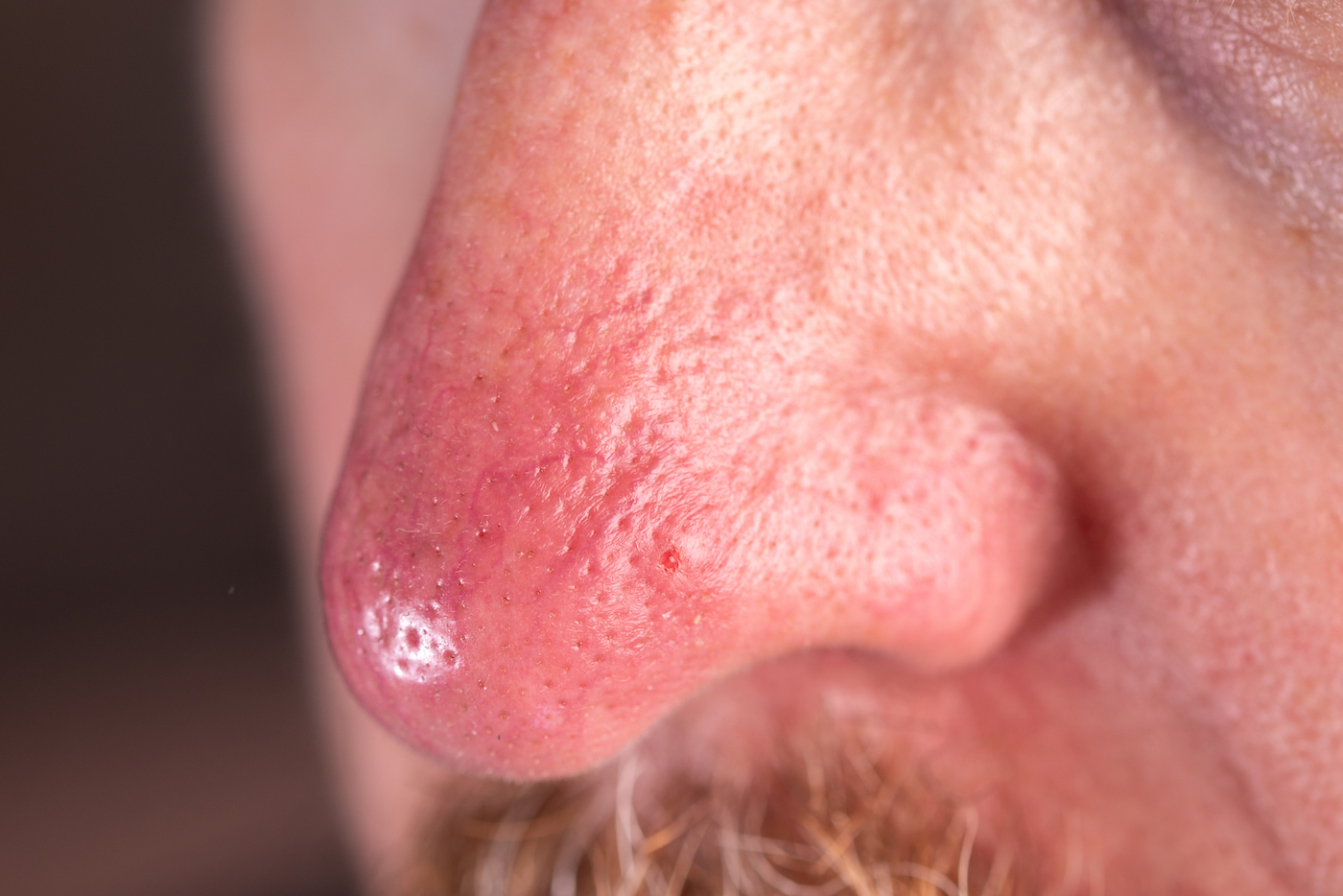
Here’s the scoop: Phymatous Rosacea can make your nose appear thicker and bumpier than usual. But it’s more than just a nose issue—it’s a signal of underlying inflammatory health issues, and it deserves our full attention.
But here’s the uplifting part—there’s light on the horizon! Treatments are getting better each year, ranging from holistic protocols to laser therapy and surgical interventions. We’re on a mission to restore your confidence and educate you about all things Rosacea.
So, come along as we explore effective lifestyle changes and the latest medical treatments to help you manage Phymatous Rosacea nose symptoms. Here’s to embarking on a journey toward clearer skin and brighter days ahead!
Key Takeaways on Type 3 Rosacea Diagnosis
- Phymatous Rosacea is a subtype of Rosacea that specifically affects the nose, causing thickening of the skin and enlargement of the nose.
- Treatment options for Phymatous Rosacea nose include topical medications, oral medications, laser therapy, and dietary and lifestyle changes.
- Rhinophyma, which is nose enlargement associated with Phymatous Rosacea, can often be effectively reduced by lowering the body’s overall inflammation.
- Surgical methods such as electrocautery and laser surgery may potentially correct the distorted shape of the nose caused by Phymatous Rosacea, but can be costly and should be used with caution.
Understanding the Condition and Its Subtypes
Rosacea, a chronic skin condition that presents on your face, comes in four different forms, each with unique symptoms and treatments.
These are the four types of Rosacea:
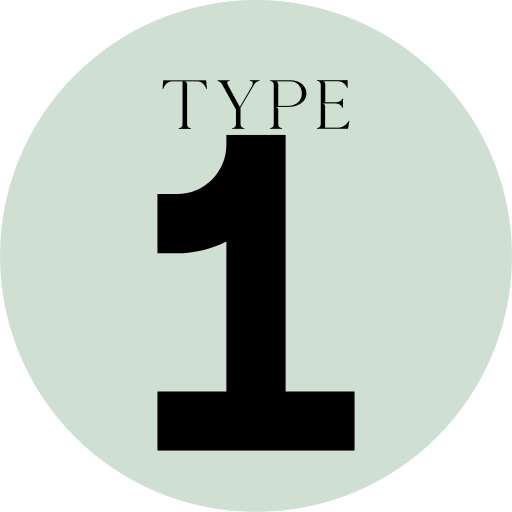 Type 1: Erythematotelangiectatic Rosacea (ETR)
Type 1: Erythematotelangiectatic Rosacea (ETR)
This subtype is identified by persistent facial redness and visible blood vessels, risking permanent intensification without treatment. It showcases the disease’s central feature: flare-ups of erythema and visible capillaries, offering a clear image of its impact.
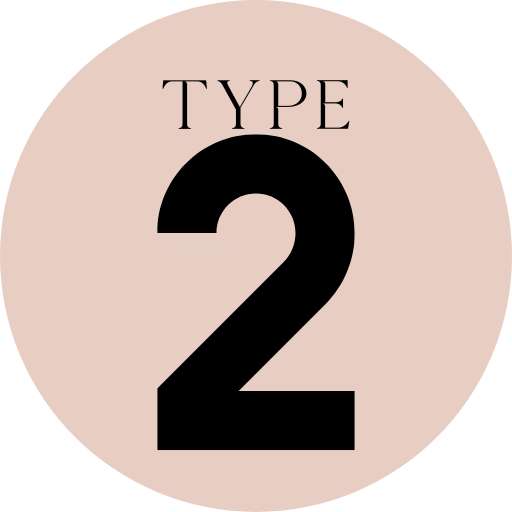 Type 2: Papulopustular Rosacea
Type 2: Papulopustular Rosacea
Diagnosed by dermatology experts, this subtype manifests as red, swollen bumps and pustules, resembling acne but distinct in its pattern and location. Severe cases can extend beyond the face, indicating an underlying systemic issue and emphasizing the disease’s persistent nature.
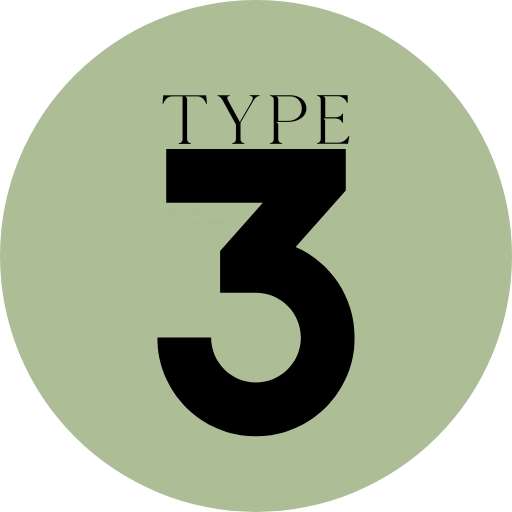 Type 3: Phymatous Rosacea
Type 3: Phymatous Rosacea
Noted for skin thickening and scarring, particularly on the nose, this subtype differentiates itself from acne through its unique texture and potential for misdiagnosis with conditions like basal cell carcinoma. This type of Rosacea often follows years of other types of Rosacea as the disease becomes more progressive.
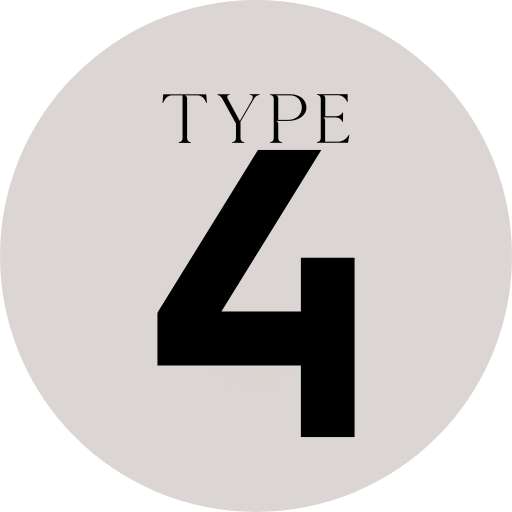 Type 4: Ocular Rosacea
Type 4: Ocular Rosacea
Characterized by eye redness, burning, and itching, this Rosacea subtype may or may not accompany facial Rosacea, presenting a diagnostic challenge that may intersect with conditions like blepharitis or conjunctivitis.2 It often occurs in conjunction with other types of rosacea, drawing attention from the national and international dermatological and optometric communities.3
Identifying Patient Rosacea Triggers
To confirm your Rosacea diagnosis, you can pay attention to typical “Rosacea triggers,” which often cause an immediate flare-up.4
Unlike acne, Rosacea flares can come on suddenly and for no obvious reason.
Every day presents a new clue: perhaps it’s a spicy meal that ignites your skin, an intense workout that brings on a flush, or the sun’s rays causing inflammation. While these triggers are extremely frustrating, it’s important to note that avoiding these activities will NOT heal your Rosacea. In fact, avoidance often leads to a lifetime of “management” and depression.
While certain triggers, like alcohol, should certainly be avoided, others, like exercise, should be continued, but with modifications to avoid severe flushing. For example, exercise in the early morning or in an air-conditioned building and use a cooling towel around your neck to prevent overheating.
Recognizing Phymatous Rosacea Signs & Symptoms
So, you’ve learned about the different forms of Rosacea, from the redness of Erythematotelangiectatic Rosacea to the acne-like bumps of papulopustular Rosacea. But now, let’s dive into the nose-specific subtype that really knows how to make an entrance – Phymatous Rosacea.
This condition not only can be frustrating and embarrassing, it comes with some telltale signs and symptoms that you need to be aware of.
Here are the key signs and symptoms of Type 3 Phymatous Rosacea:
- Redness, flushing, and or visible blood vessels on the nose
- Thickening skin, irregular surface nodules, and enlargement (most often) of the nose
- Broken blood vessels on the nose with some pitting and possible distortion in more advanced stages
- Other areas that may be affected are the forehead, chin, cheeks and ears
Now that you know what to look out for, it’s time to consider what you can do to improve your outcome. Treatment options for Phymatous Rosacea nose and rhinophyma include topical and oral medications, laser therapy, and diet/lifestyle changes.
Understanding Triggers for Phymatous Rosacea Flare-Ups
You may already be familiar with typical rosacea triggers, but what about Phymatous Rosacea triggers? Let’s explore the world of Phymatous Rosacea nose flare-ups.
- The Phymatous Changes: During a flare-up, the phymatous changes in your skin can become more pronounced because often only your nose will react. For example, a classic red nose characteristic of Rosacea.
- The Unpredictable Culprits: Phymatous Rosacea flare-ups can be triggered by a wide range of factors. Consider direct sunlight, alcohol, overheating, windburn, social anxiety and reactions to spicy food.
- End the Rollercoaster Ride: Flare-ups can be unpredictable and can vary in intensity. You can pinpoint specific triggers by keeping a daily log of your activities, foods, and flare-ups. 5 Experimenting with lifestyle changes, like adjusting your diet or activities, can significantly impact your Rosacea management, aiming for clearer, more comfortable skin day by day.
Natural Treatments for Phymatous Rosacea Nose Symptoms
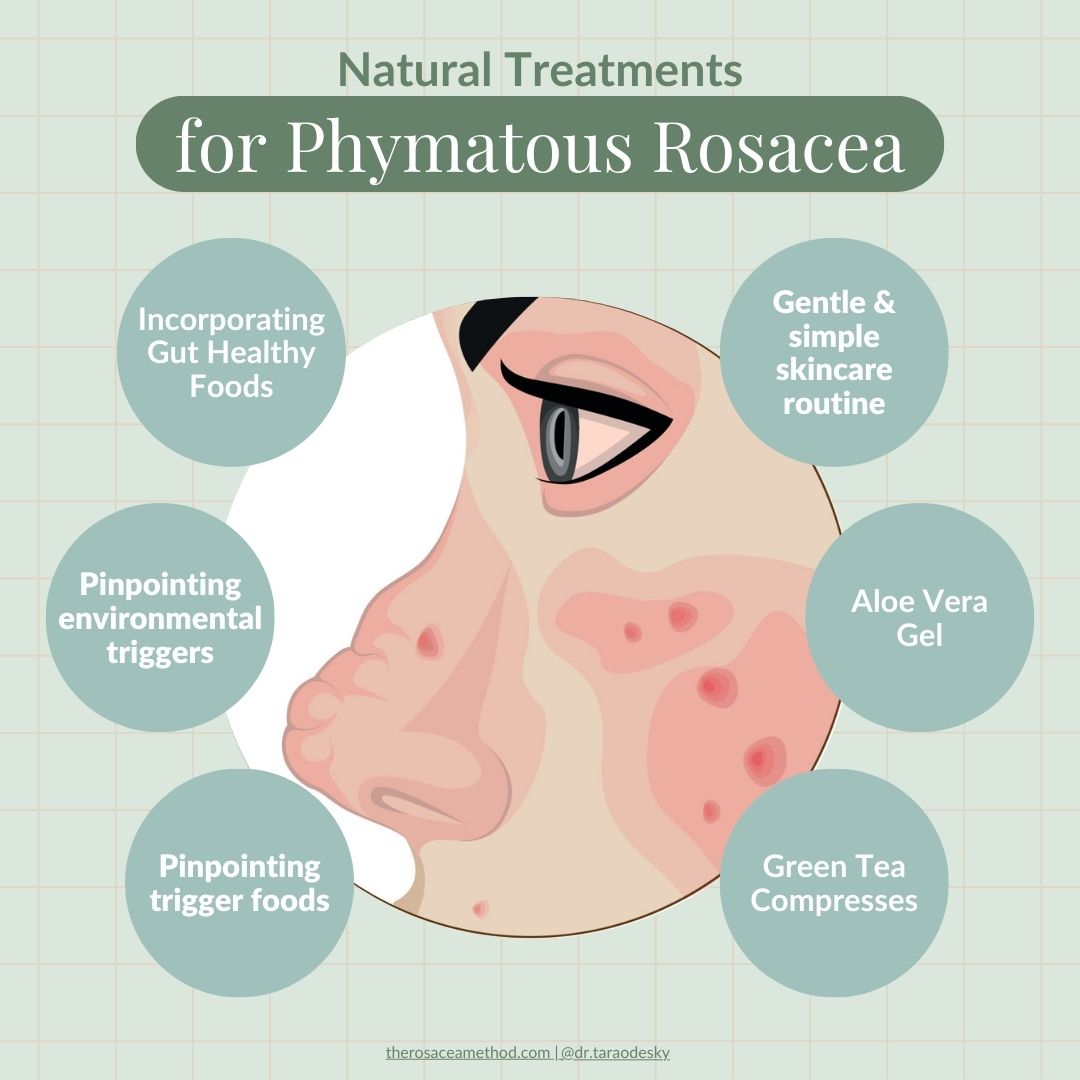
Natural treatments can be a great option when it comes to finding relief for your Rosacea subtype. Not only are they gentle on the skin, but they also offer a more holistic approach to managing your symptoms. Take a look at the table below for some insightful ideas on natural treatments for Phymatous Rosacea:
| Natural Treatments for Phymatous Rosacea |
|---|
| 1. Green tea compresses – Apply cooled green tea bags to the affected area to reduce inflammation and redness. |
| 2. Aloe vera gel – Known for its soothing properties, applying aloe vera gel can help calm irritated skin and promote healing. |
| 3. Internal Inflammation – Reducing your internal inflammatory levels can have a very positive impact not just on your skin, but on your overall health. |
These natural treatments can complement your current treatment plan and help alleviate the symptoms of Phymatous Rosacea.
Remember, it’s always important to consult with a healthcare professional before trying any new treatments. So why not give these natural remedies a try and give your skin the freedom it deserves?
The Gut-Skin Connection for People with Phymatous Rosacea
Taking on the task of figuring out what foods trigger flare-ups and what foods help with symptoms can be complicated to take on alone. Thankfully, we’ve done our research and can break it down for you! Let’s explore the fascinating connection between your gut health and Rosacea that could hold the key to managing your symptoms!
It turns out that what’s going on in your gut may directly impact your Rosacea.6 Here’s what you need to know:
- Gut Health: Did you know that poor gut health can contribute to chronic skin conditions like Phymatous Rosacea? Research has shown that there’s evidence of a link between poor gut health and the development of Rosacea. So, taking care of your gut may help improve your skin.
- Healing from Within: The good news is that you have the power to improve both your gut health and your Rosacea symptoms. You can support your body’s natural healing process by incorporating a rosacea diet plan with foods that promote gut healing, like probiotics and herbal mint tea.
- Rosacea Trigger Foods: While there are foods that can help, there are also foods that can destroy your gut health. Medications, alcohol, and fast food have been known to cause leaky gut, as well as aggravate Rosacea symptoms. So, it may be wise to avoid these if you want to keep your nose in check.
Medical Treatments for Phymatous Rosacea
So, you’ve got Phymatous Rosacea on your nose, and you’re wondering about medical treatments? Well, there are definitely some pros and cons. Let’s dive into each one so you can decide which sounds like the best option for you.
![Graphic defining Rhinophyma as a noun, with pronunciation [rhi-no-phy-ma], and a description that reads: 'Rhinophyma is a skin condition characterized by a large, red, bumpy nose caused by the overgrowth of the oil-producing glands and connective tissue. It’s often associated with severe rosacea, a long-term skin condition that typically affects the face.](https://therosaceamethod.com/wp-content/uploads/2024/04/rhinophyma-Phymatous-Rosacea-Nose-The-Rosacea-Method-Dr.-Tara-Odesky-300x300.jpg)
Topical Treatments for Managing Type 3 Phymatous Rosacea
Topical treatments offer a targeted approach to address the symptoms and improve the appearance of the affected nose.7
While topical prescription creams are a common go-to for managing Phymatous Rosacea, our approach encourages a deeper look at holistic alternatives. We believe in the power of natural wellness strategies, emphasizing that dietary, emotional, and lifestyle adjustments can profoundly impact your journey toward clearer skin.
Skincare for rosacea is a booming industry, with promises of skin clearance and a youthful glow. Unfortunately, most people with rosacea end up with cabinets full of pricey miracle creams that caused an immediate flareup. Instead, remember that less is more. Stick with a clean, basic cleanser and moisturizer when needed. Muti step exfoliants, serums, potions and scrubs should be avoided at all costs.
Oral Medications in Treating Severe Rhinophyma Nose
Oral medications like antibiotics for Phymatous Rosacea nose treatment can potentially reduce the inflammation and swelling that contribute to the enlargement of the nose.8 However, antibiotics are not meant to be taken long term, even in small dosages, and side effects should always be considered before trying these pharmaceuticals.
Understanding the broader effects of antibiotics on your body’s microbiome is crucial. Encouraging dialogue with healthcare professionals about natural alternatives can help address the root causes of your symptoms, fostering long-term health over temporary relief.
Laser Therapy for Rhinophyma and Facial Redness
While laser therapy might seem like a quick fix for Rhinophyma and facial redness, it’s essential to approach it with caution, especially for those with Rosacea.
Laser therapy is often promoted for Rosacea symptoms, known for its precision and effectiveness for Phytamous Rosacea. It uses focused light to reduce redness and reshape the nose in rhinophyma by targeting blood vessels and excess tissue.9
While laser therapy may offer relief for some rosacea symptoms, it’s important to weigh its temporary benefits against potential long term skin sensitivity. It’s a reminder that while technology offers solutions, they may not suit everyone’s condition or budget. Consult with your healthcare provider to tailor your care plan and determine if laser therapy is right for you.
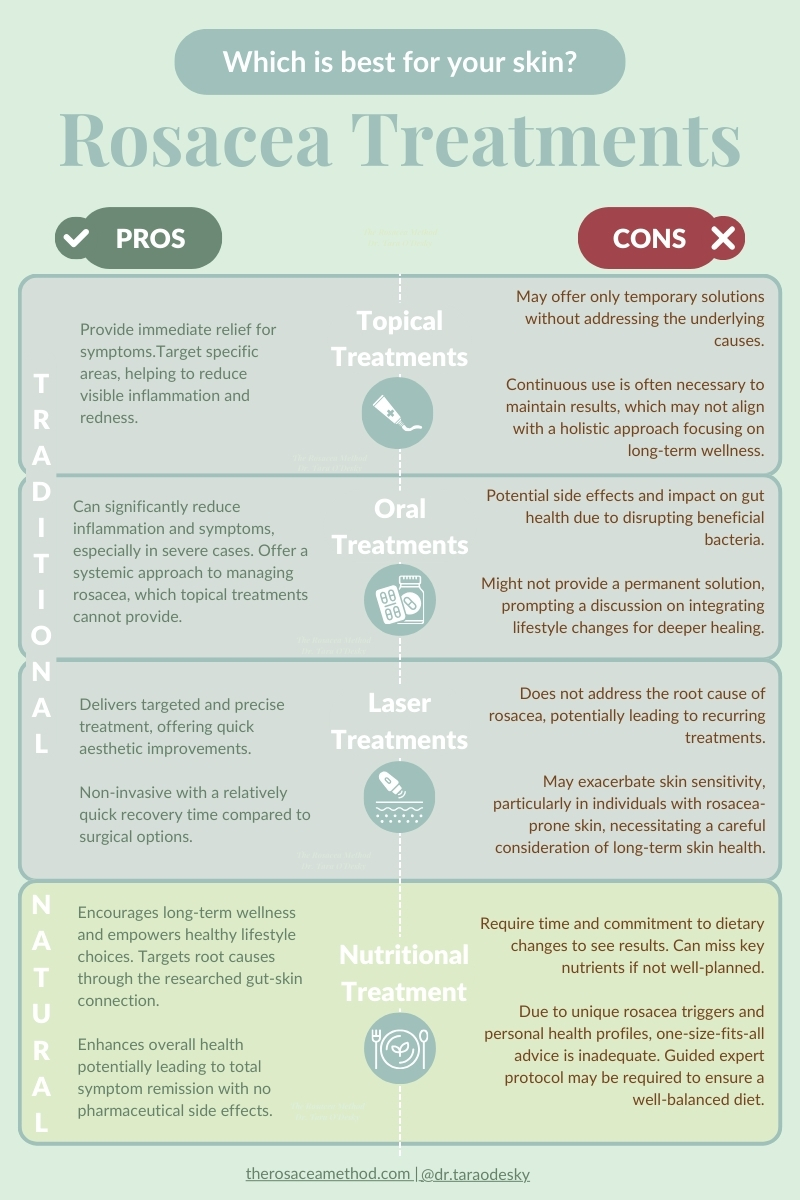
Choosing the Right Treatment for Rosacea Type 3 Care
Choosing the right treatment for Rosacea care can be a daunting task, but not to worry, there are both natural and medical options available to help you on your journey to clearer skin and a healthier nose. Let’s take a look at the table below to see the different treatment options for Phymatous Rosacea and nose enlargement:
| Natural Treatment | Medical Treatment |
|---|---|
| Lifestyle changes to reduce overall inflammation | Laser therapy to reduce excess tissue |
| Using gentle, non-chemical skincare products | Topical medications like metronidazole |
| Nutrition to target root causes of flare-ups | Oral medications like doxycycline |
Demodex mite treatment should also be a consideration when dealing with Type 3 Phymatous Rosacea. Recent studies have shown promising results when the population of demodex mites on Rosacea skin is reduced. There are both natural and pharmaceutical options to consider, and this may be a very effective option for those dealing with rhinophyma.
Now, you might be wondering which option to choose. Well, it depends on your condition’s severity and what your healthcare provider recommends.
Getting Diagnosed With Phymatous Rosacea
Wondering if your facial Rosacea is slowly developing into Phymatous Rosacea? Look out for signs like a larger nose or tougher skin, but know that symptoms can develop slowly over time. If you’re puzzled, it’s wise to chat with your healthcare provider for a clear diagnosis.
You’re not alone—plenty of people are on this path with you, and there are numerous ways your healthcare team can support you in managing and enhancing your skin’s health.
Understanding the Role of Healthcare Providers in Rosacea Management
Your dermatologist is essential in your Rosacea journey. They’re crucial in diagnosing Phymatous Rosacea, and can offer you traditional treatments like medications and laser therapy.
If you’re not satisfied with managing and treating rosacea for the rest of your life, you’ll want to consult with a holistic Rosacea specialist who can navigate the natural treatment options, understanding the benefits and potential adverse effects, and ensuring that every step taken is a measured one for your health and well-being.
Unlocking Confidence:
Navigating Phymatous Rosacea Nose Relief with Clarity & Comfort
After months or years of discomfort associated with your Rosacea symptoms, we hope you’ve found valuable insights and solutions in our exploration of Type 3 Rosacea.
Our goal is to offer you high-quality content that delves into deep expertise, answering your questions and providing holistic solutions beyond just medical interventions.
Your journey to clearer skin is unique, and we’re here to support you with knowledge and solutions that resonate with your lifestyle and preferences.
Embrace a clearer skin future – Begin your transformation with our community today!
FAQs on Phymatous Rosacea Nose & Face Symptoms
What is Phymatous Rosacea?
Phymatous Rosacea is a subtype of rosacea that primarily affects the skin on the nose and possibly other areas of the face. It is characterized by the thickening of the skin, enlargement of the sebaceous glands, and sometimes the appearance of nodules or broken blood vessels.
What are the symptoms of Phymatous Rosacea?
Symptoms of Phymatous Rosacea may include thickened skin, enlargement of the nose (rhinophyma), appearance of nodules, and in some cases, a bumpy texture resembling an orange peel.
How is Phymatous Rosacea diagnosed?
Phymatous Rosacea is typically diagnosed based on physical examination of the skin by a healthcare provider. In some cases, a skin biopsy may be performed to confirm the diagnosis.
What are the treatments for Phymatous Rosacea?
Treatments for Phymatous Rosacea may include oral antibiotics (such as doxycycline), topical antibiotics, isotretinoin, laser therapy, and in some cases, surgery to remove excess tissue.
What is the role of antibiotics in treating Phymatous Rosacea?
Antibiotics are often prescribed to help reduce inflammation and control the overgrowth of certain bacteria on the skin, which can contribute to flare-ups of Phymatous Rosacea.
What is the connection between Phymatous Rosacea and Demodex mites?
Some studies suggest that an overabundance of Demodex mites on the skin may play a role in the development of certain types of Rosacea, including Phymatous Rosacea.
Are there any alternative treatments for Phymatous Rosacea?
Alternative treatments for Phymatous Rosacea nose and facial symptoms may include using natural demodex mite treatments and reducing overall inflammation as well as promoting gut health.
References:
- Barakji YA, Rønnstad ATM, Christensen MO, Zachariae C, Wienholtz NKF, Halling AS, Maul JT, Thomsen SF, Egeberg A, Thyssen JP. Assessment of Frequency of Rosacea Subtypes in Patients With Rosacea: A Systematic Review and Meta-analysis. JAMA Dermatol. 2022 Jun 1;158(6):617-625. doi: 10.1001/jamadermatol.2022.0526. PMID: 35385049; PMCID: PMC8988027. ↩︎
- Buddenkotte J, Steinhoff M. Recent advances in understanding and managing rosacea. F1000Res. 2018 Dec 3;7:F1000 Faculty Rev-1885. doi: 10.12688/f1000research.16537.1. PMID: 30631431; PMCID: PMC6281021. ↩︎
- Oliveira CMM, Almeida LMC, Bonamigo RR, Lima CWG, Bagatin E. Consensus on the therapeutic management of rosacea – Brazilian Society of Dermatology. An Bras Dermatol. 2020 Nov-Dec;95 Suppl 1(Suppl 1):53-69. doi: 10.1016/j.abd.2020.08.001. Epub 2020 Oct 10. PMID: 33172727; PMCID: PMC7772594. ↩︎
- Oliveira CMM, Almeida LMC, Bonamigo RR, Lima CWG, Bagatin E. Consensus on the therapeutic management of rosacea – Brazilian Society of Dermatology. An Bras Dermatol. 2020 Nov-Dec;95 Suppl 1(Suppl 1):53-69. doi: 10.1016/j.abd.2020.08.001. Epub 2020 Oct 10. PMID: 33172727; PMCID: PMC7772594. ↩︎
- Paiva-Santos AC, Gonçalves T, Peixoto D, Pires PC, Velsankar K, Jha NK, Chavda VP, Mohammad IS, Cefali LC, Mazzola PG, Mascarenhas-Melo F, Veiga F. Rosacea Topical Treatment and Care: From Traditional to New Drug Delivery Systems. Mol Pharm. 2023 Aug 7;20(8):3804-3828. doi: 10.1021/acs.molpharmaceut.3c00324. Epub 2023 Jul 21. PMID: 37478169; PMCID: PMC10410666. ↩︎
- Kim HS. Microbiota in Rosacea. Am J Clin Dermatol. 2020 Sep;21(Suppl 1):25-35. doi: 10.1007/s40257-020-00546-8. PMID: 32914214; PMCID: PMC7584533. ↩︎
- Paiva-Santos AC, Gonçalves T, Peixoto D, Pires PC, Velsankar K, Jha NK, Chavda VP, Mohammad IS, Cefali LC, Mazzola PG, Mascarenhas-Melo F, Veiga F. Rosacea Topical Treatment and Care: From Traditional to New Drug Delivery Systems. Mol Pharm. 2023 Aug 7;20(8):3804-3828. doi: 10.1021/acs.molpharmaceut.3c00324. Epub 2023 Jul 21. PMID: 37478169; PMCID: PMC10410666. ↩︎
- Paiva-Santos AC, Gonçalves T, Peixoto D, Pires PC, Velsankar K, Jha NK, Chavda VP, Mohammad IS, Cefali LC, Mazzola PG, Mascarenhas-Melo F, Veiga F. Rosacea Topical Treatment and Care: From Traditional to New Drug Delivery Systems. Mol Pharm. 2023 Aug 7;20(8):3804-3828. doi: 10.1021/acs.molpharmaceut.3c00324. Epub 2023 Jul 21. PMID: 37478169; PMCID: PMC10410666. ↩︎
- Dick MK, Patel BC. Rhinophyma. [Updated 2023 Aug 8]. In: StatPearls [Internet]. Treasure Island (FL): StatPearls Publishing; 2024 Jan-. Available from: https://www.ncbi.nlm.nih.gov/books/NBK544373/ ↩︎
MEDICAL DISCLAIMER
This content is for informational and educational purposes only. It is not intended to provide medical advice or to take the place of such advice or treatment from a personal physician. All readers/viewers of this content are advised to consult their doctors or qualified health professionals regarding specific health questions. Neither Dr. Tara O’Desky nor the publisher of this content takes responsibility for possible health consequences of any person or persons reading or following the information in this educational content. All viewers of this content, especially those taking prescription or over-the-counter medications, should consult their physicians before beginning any nutrition, supplement or lifestyle program.
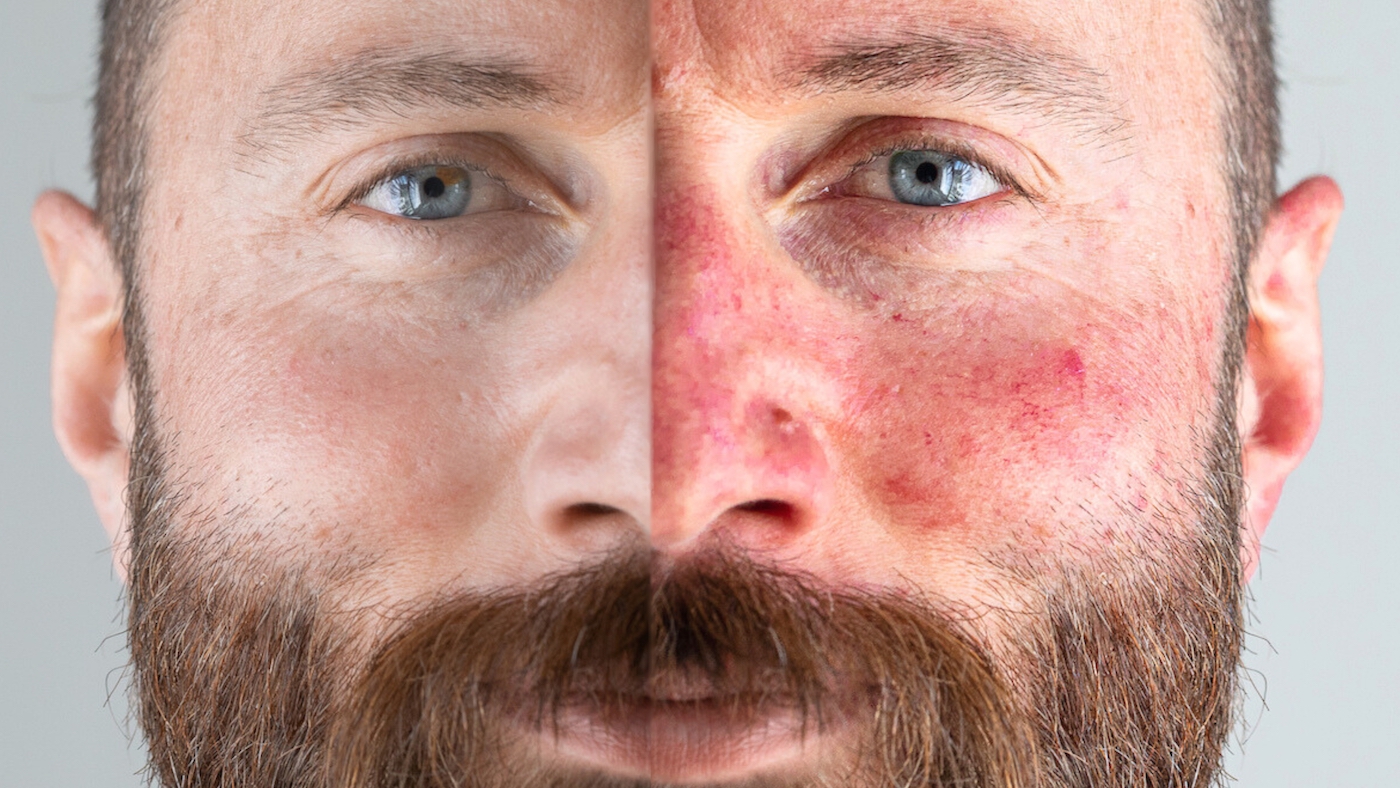
Leave a Reply
Learn More About Me
20 years of rosacea
- rosacea
- chronic skin issues
- gut issues
- food sensitivities
- inflammatory conditions
After 20 years of ineffective treatments and medications, Dr. O'Desky reversed her rosacea 100% through dietary changes and food-based medicine.
Health Coach & Holistic Skin Expert
Meet
Dr. Tara O'Desky
Since developing her own holistic healing program,
The Rosacea Method, she has helped countless patients of all ages with:
- rosacea
- chronic skin issues
- gut health
- food sensitivities
- inflammatory conditions
Dr. O'Desky continues to see patients in private practice in the USA and also sees clients via Telehealth. She currently offers various programs and workshops for people all over the world dealing with chronic health issues, poor gut health, and rosacea.
Health Coach and Holistic Skin Expert
Meet Dr. Tara O'Desky
-L. M.
"I want to say thank you so much for the program!
I never feel hungry anymore. My diet has opened up a ton and I feel really healthy and excited learning that there’s so many things I can eat now that are healthy and tasty. I felt good through the entire cleanse and my skin has definitely improved."
-Anonymous
"I felt so hopeless and I could not see light at the end of the tunnel. Now I have hope again and I feel more positive about my situation overall! Yes it can definitely heal, I have so so sure others heal! This program is great, I feel like It covers everything! Thank you! "
-Darlene B
"For the first time in 6 years, I feel like I have been given a clear direction to go in that will actually heal my skin. There's so much guess work that comes along with skin complications and Tara helps to clear all that up.Recommend 1000%."
So much information, and so informative. Thank you!
You’re so welcome!
My nose is my main problem area. Thank you for all the information.
You’re so welcome!
Do supplements help out?
This is interesting and helpful. However, there is no mention of ivermectin solutions which target the mites that also cause rosacea. These are coming along and are very helpful.
Hi Lexie, thank you for your comment. Mites do not cause rosacea. All human skin has demodex mites. Some people with rosacea can react to the mites, almost like an allergic reaction which causes a worsening of symptoms. Certain medications can kill the mites, but this does not address what’s causing rosacea or internal inflammation.
This blog is very interesting and helpful
I’m glad I found you.